IEDs: A Different Approach

Traditionally, training on improvised explosive devices (IEDs) has focused on how to recognize one, or how to differentiate a “suspicious” package from any other object in your environment. We might discuss how different IEDs are constructed, or what they are made of.
All of which is good to know.
Training about how to react to IEDs has focused on the mantra of Time, Distance, and Shielding (TD&S)–all of which are also great. Distance and Shielding are obvious; Time, in that context, means minimizing the time you are near the suspected device.
The only real difference in our response from one IED to another was in how much TD&S it rated. Bigger bombs (for example, VBIEDs–Vehicle-Borne IEDs, like in Oklahoma City), require more TD&S.
Well, duh.

Responses based on Employment, rather than Construction
In order to expand your repertoire of ways to deal with IEDs, we should focus, instead, on how the IED is used against us. Toward that end, it’s helpful to study how NON-improvised explosives are employed.
When we teach any weapons, we differentiate between Purpose-Built and Improvised / Field Expedient. A PR-24 baton, for example, is a purpose-built impact weapon. A table lamp might do, if you need to improvise an impact tool from your environment in a flash fight.
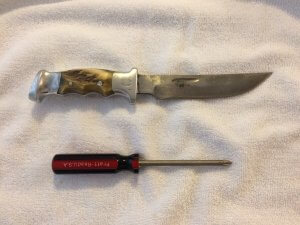
Purpose-Built explosives include land mines, guided missiles, and grenades. Each of those has a different raison d’etre / tactical niche / means of employment.
Looking at HOW IEDs ARE USED, rather than how they are built, we see that IEDs, while field expedient, are employed analogously to land mines, guided missiles, and grenades, as area denial bombs, suicide bombs, and tossed bombs.
Part I: IEDs for Area Denial
Historically, homemade bombs have been used like land mines.
They can kill people who wander into a certain area, effectively denying people the use of selected real estate.
- Most commonly, in America, this manifests itself in the bomb threat: “I didn’t study enough for my final today, so I’ll call in a bomb threat and they’ll cancel school.” Denying teachers and students access to the school is intended to prevent the test from being administered, at least in that location.
- The 9/11 hijackers pretended to have bombs in order to cow the passengers into submission and keep the passengers, who vastly outnumbered the hijackers, away from the cockpit.
- Booby traps left for first responders fall into the Area Denial category. The “Joker” wannabe who attacked the Century 16 Theater in Aurora, Colorado on 20 July 2012 booby trapped his apartment to kill the detectives who would inevitably serve a search warrant there after his heinous mass murder.
- Rampage killers, such as the active shooters at Columbine, have used bombs in an attempt to channel or stampede their victims into pre-selected areas for small arms ambush. Such complex attacks are common overseas, where a bomb goes off in a mosque, then shooters gun down the faithful as they bail out of the exits.
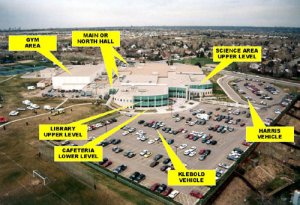
The killers at Columbine planted large bombs by the support columns holding the library up over the cafeteria. They timed the bombs to go off during peak lunchroom usage, which they had researched extensively, counting the students and taking notes, during months of pre-strike surveillance that nobody found notable enough to report. They waited in a classic L-shaped ambush by their cars to gun down anyone escaping the carnage in the cafeteria. Only when their bombs did not go off did they reformulate their plan and start their killing spree in the school.
Response to Area Denial Attacks
Finding the Bomb
For many people, especially organizations who can expect IED ambushes–for example, logisticians running supply convoys (the true unsung heroes of the Global War on Terror)–the key is to find the bomb before it finds you.
IED Recognition
…is difficult, because IEDs can be built into many common objects, but most domestic bomb builders are not that sophisticated, and their bombs end up looking like bombs.
All IEDs require certain components. Triggering mechanisms such as trip wires and pressure plates may be easier to spot than the bomb which may be out of sight.

I spent a good portion of my professional career looking for precursors and “bomb factory” components in the homes of persons from countries with an al-Qaeda presence, or searching for bombs in vehicles entering secure / nuclear facilities.

I’ve taken a lot of IED recognition classes and even taught a few. Some of the best practical IED identification training I’ve received was put on by A. Vazquez, Sergeant of the Arizona Department of Public Safety Bomb Squad.

Sgt Vazquez puts on a “house of horrors” with various types of simulated IEDs and triggering devices. If a “bomb” is set off (often indicated by some sort of audible electronic stimulus), the team practices how to evacuate casualties (see IEDs in Casualty Care below) and how to deal with the post-blast environment before re-setting for another run, hunting the other bombs.
In firearms training, we would call that an “unknown target” or “pop up” lane.

Bomb Threats
Unless you serve search warrants or are part of a Rescue Taskforce or Contact Team responding to an active shooter, bomb threats at your facility are probably the Area Denial attacks you are most likely to deal with.
It may not always be feasible or even desirable to evacuate a facility for every bomb threat, particularly if that facility is some sort of critical infrastructure such as a hospital, power plant, air traffic control facility, or the like. In fact, the bomber may not be able to sneak a bomb into your secure facility, but with a bomb threat he may be able to get you all in a predictable, less secure location, like a parking lot. For that reason, shelter in place may be a valid option, even with a credible threat.
Explosives detection canines are useful, if you can get them in a timely manner. Generally, the best way to search is to have those familiar with the environment–those who work or live there–look around their area. They know what belongs and what might be out of place.
Search systematically. Have one stakeholder search clockwise around the room, while another searches counter-clockwise, and overlap each other’s search areas till you have both cleared the whole room. Each time you sidestep, scan floor to ceiling.
If you locate an item of concern which might have been placed for area denial, DO NOT TOUCH IT. Do NOT sniff, shake, kick, or otherwise attempt to plumb its depths. Get a good description of the suspicious package and note its specific location before evacuating, and contact law enforcement.
For an excellent, 26 minute video of how to develop an emergency operations plan for bomb threats, watch IED Recognition for Immediate Responders on the ICSAVE.org website.
Get Away from the Threat
If you do find a suspicious package, especially one matching a description called in during a bomb threat, or an obvious bomb, get as far as possible from it. This is not rocket science, but normalcy bias and fear of looking foolish by over-reacting cause many people to linger too long.
On 27 July 1996, security guard Richard Jewell found a suspicious backpack while responding to a phoned-in bomb threat in Centennial Olympic Park. His enthusiasm to distance concert goers and stagehands from the package overcame the inertia of their normalcy bias, and saved many lives when the backpack detonated.

I was assigned to Centennial Olympic Park afterward, for the duration of the 1996 Atlanta Olympic Games. We screened people entering the park, searched for unclaimed packages, and pushed crowds away when an explosives canine hit on something (I also got paid to watch Carlos Santana play “Earth’s Cry / Heaven’s Smile”).
I knew someone close to that bombing investigation. Jewell’s enthusiasm for evacuation was so unusual, he was initially suspected of having placed the bomb himself (a right-wing extremist was later convicted of it). The lesson here: if you KNOW something is out of place, don’t be afraid to look foolish, or even suspect, getting people away from it.
Turn off your cell phones?
Technically, RF energy from cell phones could, possibly, set off a device.
But let’s think about that.
Your cell phone has been on since you got there this morning. You ignored a few calls that were probably telemarketers; you took two calls from your boss and another from your spouse, and your mother-in-law left a message about how you never answer. You called your friends to endlessly debate where to meet for lunch, and you made a few business calls.
Somehow all those calls–plus the internet video games you played while the boss was in a meeting–did not set off any bombs, but now that we’ve found a suspicious package that was close by the whole time, we’re going to worry about that and turn off our cell phone? How are we going to call in the location / description of the package from our rally point in the parking lot without it?
Instead, it’s probably an acceptable risk to USE that cell phone to get quick pictures of the package AND THE SURROUNDING ENVIRONMENT, as long as you minimize the Time (remember TD&S?) you are exposed to the item of interest. You can text or email those photos to authorities after you evacuate.
Vehicle Security / Convoy Ops
- Identify areas, such as choke points, were IED ambush is likely to occur. Alfred Herrhausen varied his routes but had to take a narrow stretch through a park in Bad Hamburg, Germany. Terrorists, most likely directly aided by the Stasi, blew a platter charge hidden on a bicycle through Herrhausen’s legs on 30 Nov 1989 (course notes, NCIS Route Analysis seminar).
- Identify evidence of IEDs. This can be easy (dark, moist earth where the rest of the dirt is dry, evidence of recent “pipe laying” trenching for wires, etc), but it is usually hard, as an IED can be built into most anything. The IED that brought down Pan Am Flight 103 over Lockerbie, Scotland is believed to have been built into a Toshiba boom box. Regardless of how it was disguised, it passed airport inspection.
- If you must dismount, search the area your boots will hit, and then out from there in expanding concentric circles, for devices placed there by those who planned for you to stop there. If you are exiting due to a direct fire threat, it will be hard to tear your focus away to the ground you’re about to step (or throw your body down) on.


When my brother was in Iraq, a US Army commander let the locals pick the location of a meeting two weeks in advance. They even reserved a “VIP” parking location for his vehicle. As soon as his driver turned off their electronic countermeasures, his vehicle was vaporized.
After the bomb finds you
It seems counterintuitive, but while bombs are exploding on a crowded street–Tucson examples might be Winterhaven during the Christmas Lights season, the Tucson Meet (“Eat”) Yourself festival, or the Tour de Tucson bicycle race–and in the IMMEDIATE aftermath, the safest place to be might be where the last bomb exploded.
Native Americans downwind of a raging prairie fire would try to move perpendicular to the wind to get out of the fire’s path. It the fire was too big or closing too fast to avoid, they would light another fire AHEAD of them, then move into the burned-out area where the fire behind wouldn’t go.

Likewise, “ground zero” where the last bomb went off may be the safest place to be if a series of bombs are detonating, like at the Boston Marathon. That is where the victims will need help anyway.
However, it should be noted that secondary devices are often placed specifically to kill first responders, and immediate responders like you. If so, they will probably be timed to go off several minutes after the first, to allow time for the responders to get there. In other words, the longer you linger where the first bomb(s) detonated, the greater the danger there.
Post-blast Inhalation Hazards
If any type of bomb sets off a fire, there is an inhalation hazard from toxic byproducts of burning plastics.
Another exception to the “Run to Ground Zero” suggestion might be if the bomb was a chemical overpressure device.
The danger of a 2-liter coke bottle exploding is not from fragmentation but rather from the toxic chemicals (such as Drano or swimming pool acid) used to create the overpressure.
Due to the short time between the mixing of the ingredients in the container and the unpredictability of when the container will rupture, coke bottle bombs are more likely to be used by adolescents experimenting in empty parking lots than by terrorists.
Part II: IEDs as Guided Missiles
The IEDs used at the Boston Marathon were in one sense used like land mines, in that they were set up in fixed places, but they were not really used for area denial or to channel victims into kill zones. Rather, they were employed like guided missiles. The targets (people) were already in the area, and the bombers delivered their bombs to targets they deemed would produce maximum carnage.
One of those “rock stars” placed his backpack directly behind a child.

Governments spend millions of dollars on developing and fielding precision guided munitions, such as air-to-ground missiles, with complex electronic guidance and fusing mechanisms to maximize their chances of hitting the intended target (and minimize “collateral damage” to nearby civilians and structures).
Home grown extremists / insurgents don’t have that kind of budget . . . although many Americans (especially logisticians who ran convoys) are missing legs or suffering the long-term effects of traumatic brain injury, from explosively formed projectiles (EFPs) and other high-quality explosive devices manufactured IN Iran, by Iranians, during our conflict in Iraq.

Response to Suicide aka Homicide Bombers
The third world equivalent of a guided missile is the suicide bomber.
 The eyes and brain are the guidance system, the thumb on the plunger (and / or the “handler” with a cell phone, observing from a distance) constitute the fusing mechanism, the legs and feet the propulsion unit.
The eyes and brain are the guidance system, the thumb on the plunger (and / or the “handler” with a cell phone, observing from a distance) constitute the fusing mechanism, the legs and feet the propulsion unit.
Suicide bombers are coming to our shores, as evidenced by an unsuccessful attack against the New York subway system on December 11, 2017. There is no simple, easy solution to the suicide bomber. If he is wearing a visible vest (it will most likely be concealed right up till the point of detonation, so s/he can get to the target) it would be appropriate to shoot him or her in the head, disabling the guidance system, ideally before s/he can get into a crowd.
But suicide bombers often have a handler who will detonate the device remotely if the true believer wearing the vest is incapacitated, or loses their nerve. Many, many police, security specialists, and soldiers have lost their lives tackling or trying to arrest suicide bombers.
Incidentally, suicide bombing is one violent occupation in which females have made great strides (Prevention of and Response to Suicide Bombing Incidents, p. 2-13). Often, they are following their martyred husbands to Paradise.

Part III: IEDs as Hand Grenades
When the Boston bombers got into their Watertown shootout with police, they only had one pistol. They had murdered MIT Police Officer Sean Collier to get another, but were too stupid to figure out how to get it out of Collier’s holster.
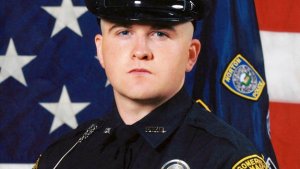
The older brother used the pistol they already had. The police had a pre-trained response to being shot at: shoot back.
The younger brother, not wanting to be left out, began sparking up fuses and hurling IEDs at the cops like hand grenades. When interviewed later, police officers who had been at the scene said that, even though they were looking for the Boston Marathon bombers, their training had not prepared them for the sights, sounds, and explosions of pipe bombs and pressure cookers being bowled at them.
Defeating IEDs
The best way to defeat any weapons system, we always say, is to get and stay outside its maximum effective range.
This advice applies to IEDs as well.
If terrain permits (and that’s an important, but often overlooked, IF), get as far away from IEDs as possible. “If you can see the bomb, the bomb can see you” (Course notes, EMRTC Homemade Explosives – Awareness, Recognition and Response).
2 Corner Rule
If terrain–such as the inside of your school–limits your ability to get away, it’s important to move perpendicular to the potential blast wave.
The wave will follow the path of least resistance, down a hall, for example.
Get into a side room, and around a corner in the room, if possible.
Picture ocean waves coming into a man-made harbor. They are strongest in front of the harbor opening, less strong 90 degrees off inside the harbor, and weaker still coming back 180 degrees around the corner of the breakwater.
Try not to get too close to walls, which can reflect blast, but do put something solid like a filing cabinet or big desk between you and the doorway. Put your hands over your ears and open your mouth.
It is almost never advisable to handle IEDs.
IEDs could have pressure sensitive switches, be made of unstable explosives, or be command detonated. One of the most horrific videos I ever saw was of a police officer (I think it was in Turkey) messing with a briefcase left on a crowded street. It blew up–but he DIDN’T die (at least not at first). Instead, what was left of his head and torso just lay there in the street, howling like an animal. I still can’t un-see or un-hear it.

But there ARE exceptions to the “don’t touch” rule.
On 9/11, the passengers on the first three hijacked planes tried to stay calm, and stayed away from the hijackers, whom they vastly outnumbered, at least partially because the hijackers said they had bombs. That did not work out so well for those passengers, nor for the people on the ground in New York or DC. Desperate times call for desperate measures. Passengers on United Flight 93, learning they would die anyway, rushed the hijackers. They were unable to save themselves (the hijacker flying the plane nosed into the ground) but they saved countless lives on the ground.
It should be comforting to note that “Radio Frequency (RF) detonated devices (also known as command detonated devices) are the least common types of devices currently found by law enforcement in the United States. Most explosive ordinance disposal (EOD) personnel have never encountered an RF detonated device outside a training scenario.” (Blair, Nichols, Burns, & Curnutt, p. 143)

Metal and plastic pipe bombs are the most common IED types in the US (Homemade Explosives: Awareness, Recognition and Response, p. 4-17).
It stands to reason that if a bomber is hurling something at you like a grenade, it most likely does NOT have a switch that makes it go off when disturbed. It may be about to explode, but your handling it won’t make it detonate any sooner.
Burning Fuse Activated IEDs
Burning fuse is still very common. Burning fuse has a core, and a water-resistant sheath.
According to Blair et al, the inner core can burn up to 6 inches ahead of the part you see burning. (Blair, Nichols, Burns, & Curnutt, p. 142)

However, an ATF EOD tech with decades of experience told me that the core is almost never more than 2 inches ahead. Often, depending on the type of fuse burning, “what you see is what you get.” (Interview with ATF Deputy Director S. D. Sweetow, 26 Dec 2017).
It should be noted that “actual mileage” (visible vs. core fuse burn) may vary, and DD Sweetow’s opinion, while well qualified (it would not be hyperbole to call him one of the world’s foremost explosives experts), did not constitute official doctrine of the Bureau of Alcohol, Tobacco, Firearms, and Explosives, nor of the US Government. DD Sweetow has since retired, and formed S3 Global Consulting.
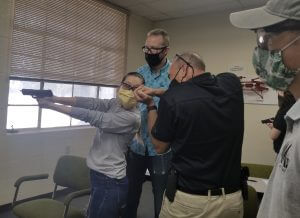
Responding to the Tossed Bomb
The Columbine killers brought nearly 100 bombs, in addition to guns, on their killing spree. They took particular glee in hurling “crickets,” which are small but dangerous up close, at their terrified classmates.

On 12 Oct 2024, a car theft suspect (who also was a fentanyl dealer) tried to light the fuse of a homemade grenade, made from a tennis ball, at officers as they chased him on foot. He was tackled before he could get the fuse lit.
First responders to rampage killer incidents are trained to yell “Bomb! Cover!” (meaning “I’ve seen a bomb; take cover”) if the IED is more than 15 feet away.
If the bomb is within 15 feet, in the midst of the responding team, or sailing past it, the mantra is “Bomb! Go!”–meaning, “Keep going toward the shooter, and let’s put this bomb behind us!” (Blair, Nichols, Burns, & Curnutt, pp. 143 – 46)

How Grenades are Employed
To defeat IEDs used as grenades, it’s instructive to learn from the military’s experience with grenades.
Hand grenades are useful against personnel in bunkers or defensive fighting positions who are “dug in deep” and hard to take out with direct fire (line of sight) weapons (FM 3-23.30, Grenades and Pyrotechnic Signals, pp. 3-9). Although every launched projectile has a curving trajectory, most small arms (except low-velocity grenade launchers) shoot “flat” for practical purposes at typical urban combat distances.
If a bad guy is on the other side of a wall, and is hard to hit with a rifle, tossing a grenade over the wall might do the job.
Likewise, an insurgent firing from a window on the third floor might be hard to hit with direct rifle fire (if the building is made of concrete or stone masonry) but lobbing a grenade into the room behind him through the window, either by hand or with a grenade launcher, might finish him off.
Mexican folk hero Don Alejo Garza Tamez singlehandedly held his hacienda against a squad of Zetas cartel enforcers, killing 4 and wounding at least 2 others, by firing rifles from his windows. He was killed when the Zetas lobbed grenades into his hacienda, on 14 Nov 2010.
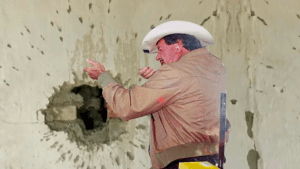
When clearing buildings (if collateral damage to civilians is not a concern), infantry soldiers toss grenades into a room before rushing in with rifles at the ready. SWAT cops serving warrants do the same thing, except with less lethal “stun” grenades, referred to officially as “Distraction Devices.” Soldiers are trained to toss grenades in an open door–hard, so the grenades don’t stop moving before they go off. This limits opportunities for the bad guys inside to toss the grenades back or kick them into a pre-dug grenade sump (a hole in the ground using the dirt to dampen or channel the explosion).
Soldiers are also given the option of punching holes through walls and slipping grenades into adjacent rooms that way (ST 90-10, Infantry Commander’s Guide for Military Operations in Urbanized Terrain, pp. D-6 to D-8). In Iraq and Afghanistan, grenades were sometimes dropped on our troops through holes in ceilings. This is nothing new. Vietnamese guerrillas did the same thing in the Hue treasury during room-to-room fighting to retake “the Triangle” (Bowden, Hue 1968, p. 285). I’m sure it happened a lot in urban areas of Europe during WWII.
Similarly, if your classroom door has a window in it, the bad guy may bust the glass and toss in a bomb, even if he can’t get in through the locked / barricaded door.
You may be hiding in a room or closet when an IED is tossed in, and unable to get away due to the architecture, or the fact that small arms fire covers likely avenues of escape (like running into the hallway).
In such an instance, well-meaning advice such as “never touch an IED” is useless. Less than useless, actually, because it fails to give you other options and trains you for an option that WILL, in that situation, get you killed.
If this is so, why does ALL the related literature I’ve read say “If you are not a trained EOD technician, never get near or touch a bomb”? Mostly, because that used to be sound advice, and it still is, in instances where a bomb or suspicious package is located by itself AND YOU CAN GET AWAY. In other words, it is a response to area denial, which may not be the IED deployment situation du jour. When Distance is possible, it is always preferred.
Unfortunately, modern rampage killers often strive to attack masses who are trapped in a confined area and can’t get out. Some have even chained exit doors shut (Virginia Tech 16 Apr 2007) or parked a car against a back door (American Civic Association, Binghamton, NY 04 Apr 2009) to prevent their victims from escaping.
Thanks to the inspiration of the Boston bombers, I predict that tossing bombs like hand grenades will become an emerging trend. We must strive to stay ahead of rampage killer TTPs (tactics, techniques, and procedures), rather than training exclusively to win the last war.

Jumping on IEDs?
The most noble thing a person can do when a bomb is tossed into a crowd is shield her or his brothers and sisters with her or his body.
While “there be no greater love than this,” Heloderm LLC does not advise diving onto IEDs.
Toss it Back or Out
Anthony B. Herbert, a highly decorated American soldier from the Korean and Vietnam Wars, wrote that he hated when his troops jumped on grenades, because then he was certain to lose one more soldier. He personally preferred to pick grenades up and toss them back at the North Koreans and Chinese. It didn’t always work, but jumping on a grenade ALWAYS got a UN troop killed.
On 07 May 1970, PFC Ken David picked up several satchel charges that had been thrown into the perimeter of Fire Support Base Maureen and tossed them back at the “Charlies” of Thua Thien province, Vietnam.
“. . . when the grenades fell in, you threw them out. That was the only way to survive.”
–SFC Webster Anderson, Medal of Honor recipient
Anderson, David, and Herbert didn’t invent that TTP. Turkish M1914 grenades (literally spherical metal bombs with burning exterior fuses, like in old cartoons) used at Gallipoli in World War I initially had 10 second fuses, but were eventually cut to 5 seconds because the Aussie and British soldiers would often throw them back. Some sources say the Turkish fuses burned as long as 19 seconds, which would be long enough to trade hands several times (Sweetow, 26 Dec 2017).
It might not be polite to toss an IED back at an active shooter who is surrounded by wounded victims, but if he is by himself, please do.
Or, you might be able to toss it out a window into a vacant parking lot. A swimming pool would be, and sometimes is, handy for relatively safe disposal.
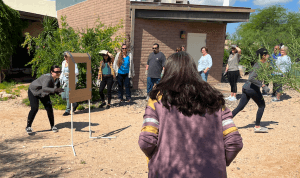
Cut Burning Fuse
Another option, if you have a pair of trauma shears, would simply be to cut the fuse. If you have no shears, but you do have a knife, you might be able to step on the fuse, grab the bomb, pull it taught, and cut the burning fuse. Regardless of how, cut the burning fuse as close to the bomb as possible.
Even after you cut it, do NOT consider the bomb body “safe.” Get as far away from it (or get it as far away from you) as possible.
You MUST Get Hands-On Practice
However, it is one thing to talk about cutting fuses or tossing IEDs in an air-conditioned classroom setting (or read about it while curled up with your laptop). It’s quite another to actually do it when one is at your feet. If you’ve never, ever, practiced it, chances of you “rising to the occasion” during such a shocking situation in a timely enough manner are lower.
Even soldiers first learning basic infantry skills are discouraged from reaching for dropped grenades. I’ll never forget the briefing given to us by the old SF sergeant:
“This is MY grenade. I will let you throw it, but it is MY grenade. If you drop MY grenade in our bunker, do NOT reach for it. Get out of MY way. I will take care of you, me, and MY grenade.”
This was meant to prevent fumbling by nervous, inexperienced soldiers, the first time they held something so powerful and destructive in their shaking hands (before that, they had only practiced with inert simulators).
But just as treating shooting students like Barney Fife on the firing line creates an army of Barney Fifes, our understandable abundance of caution about explosives creates fear and panic, rather than competence.
“It is of immense importance that the soldier, high or low, whatever rank he has, should not have to encounter in War those things which, when seen for the first time, set him in astonishment and perplexity; if he has only met with them one single time before, even by that he is half acquainted with them.”
–Carl von Clausewitz, On War, p. 168
That’s why, when Heloderm teaches IEDs, students get hands-on practice playing “Hot Potato,” first with a non-fused, inert simulator, and then with a simulated PVC pipe bomb (weighted with clay, rather than explosives) that has a burning fuse. This is harder than it sounds, when the fuse is hissing and burning. Eye protection is essential. Long sleeves and gloves are preferred. It’s also a good idea to have somebody standing by with a fire extinguisher in case the fuse ignites grass or brush.

Heloderm LLC is the only training organization I am aware of teaching civilians to immediately return IEDs tossed at them, if one cannot otherwise create sufficient distance from the bomb. I am not a genius and I am sure I am not the only one who has figured this out. Why, then, do other schools still forbid you to touch IEDs?
Instructor liability may have something to do with it. If we tell you never to touch an IED, we probably can’t get sued, even if one kills you. But if we teach you to toss them back at the bad guy, and one blows up in your hand, some ambulance chaser might say it’s our fault (hardly anybody ever sues the killer; most of them have no money to go after, and they are usually dead or in jail).
And make no mistake: an IED could very well go off as you are reaching for it, after you pick it up, or right after you throw it.
On 26 May 2008, US Army SSG Leroy A. Petry grabbed a Taliban grenade that landed near him, and threw it away from his comrades. He saved their lives, and his own, but it went off close enough to cost him his hand.
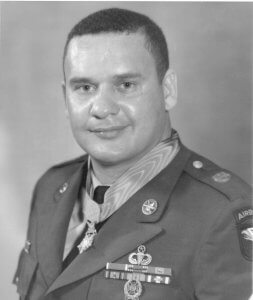
On 15 Oct 1967, near Tam Ky, Republic of Vietnam, US Army SSG Webster Anderson, already wounded badly enough in the legs by other grenades to subsequently lose both, saw yet another grenade land near a wounded soldier. SSG Anderson picked it up and threw it. The act saved his wounded comrade–but as with SSG Petry four decades later, it cost him his hand.
Later, when asked if he would do it again, knowing what it would cost him, Anderson replied,
“Young man, I have only one arm left, but my country can have it any time they want.”
As Michener wrote in The Bridges at Toko-Ri, “Where did we get such men?”
I will continue to teach this response to IEDs used as grenades. It’s unlikely you will ever need it, but if you do, it simply WILL NOT HAPPEN without practice.

Summary of these IED Tactics, Techniques, & Procedures
IED training, like teaching young children about firearms, should start with recognition and avoidance. The Eddie Eagle mantra I taught to young kids about guns (and reiterated to my daughter when she went to the prom) applies:
- Stop!
- Don’t touch!
- Run away!
- Tell a grownup!
But our IED training should not stop there.
If your facility receives a bomb threat, have those who work there search their workspace before evacuating, identifying anything suspicious or out of place.
Once something is identified as suspicious, do NOT take no for an answer when people resist evacuation.
Suicide bombers often disguise their bombs like a body carrier hides drugs. If one actually shows you the strapped-on bomb, get as far away as possible. If you cannot get away and detonation may be imminent, attack the guidance system–his or her head–violently, decisively, and with little remorse. THEN get away, because there could be a timer or remote detonation backup.
If you are on a contact team hunting an active killer and a bomb is tossed at you like a grenade:
- If the bomb falls short (5 yards or more), yell “Bomb! Cover!” Move off to the side and bunker down around something else solid. Plug your ears, close your eyes and open your mouth.
- If the bomb lands among you or behind you, yell “Bomb! Go!” Move past it, fast.
If you are hiding from an active killer and a tossed bomb enters your space and you cannot get away:
- Toss the bomb back, or at least somewhere else.
- If you cannot get rid of it, cut the burning fuse as close to the bomb as possible.
The Future of IEDs on American Soil
Improvised Explosive Devices are nothing new. Many of our students who are veterans of the Global War on Terror have long and oft-tragic experience with them.
They are coming here.
Due to the internet, and inadvertent importation of expert bomb makers through our broken immigration system, the use of IEDs in all sorts of crimes, particularly in domestic killing sprees and other forms of terrorism, will become increasingly prevalent in the US.
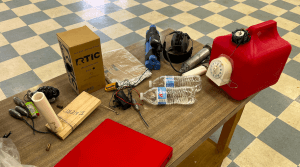
Often times, those trained, experienced, motivated bomb makers have exploited, among other things, our well-intended asylum & refugee resettlement programs. That’s not right-wing reactionary “poisoned skittles” hyperbole. The TEDAC has assisted with the successful prosecution of foreign bomb makers who came to the United States, whose fingerprints / DNA were found on components from IEDs that murdered civilians and soldiers overseas.
For some reason, the convictions of these bomb makers never seem to be front page news.
Where we have been unable to prove beyond a reasonable doubt that they made the bombs, some of us who still have immigration investigation expertise have at least been able to assist in their deportation.
Conclusion
Our response to IEDs continues to be reactive, rather than pro-active. Our IED training tends to focus only on area denial attacks. That’s a great place to start, but we can do so much more.
Trainers, be bold and train your students to survive the IED employment methods of the future, not just the area denial of the past.
–George H, Lead Instructor, Heloderm LLC
Additional Reading: IEDs and Casualty Care
To learn how explosive threats affect the practice of Tactical Medicine, read IEDs and Casualty Care in the TacMed category of this website. To learn more about IEDs in general, and our responses to them, here are some of the sources that helped with my research.
Selected Sources
J. Pete Blair, Terry Nichols, David Burns, and John R. Curnutt, Active Shooter Events and Response (Boca Raton, FL: CRC Press, 2013. This book was researched and produced by the ALERRT Center at Texas State University San Marcos. ALERRT stands for Advanced Law Enforcement Rapid Response Training.
Nathan Clark, “Suspect Throws Pipe Bombs, Opens Fire at Mich. Officers During Pursuit” (mlive.com via Police1.com, 26 Nov 2024).
Carl von Clausewitz, On War. J.J. Graham, trans. Anatol Rapoport, ed. (New York: Viking Penguin, 1968).
Dave Cullen, Columbine (New York: Hachette Book Group, 2016).
Course notes, Route Analysis and Attack Recognition seminar, US Embassy, Kuwait City, March 04, 2008. Our instructor was NCIS Physical Security Specialist Donald M. Gracio.
Elizabeth DePompei, “History Makers: Meet 3 women and DAV members who stared down adversity and thrived against the odds” (DAV Magazine, March / April 2025), pp. 10 – 12.
Field Manual 3-23.30, Grenades and Pyrotechnic Signals (Washington, DC: GPO, 2000).
Anthony B. Herbert, Herbert: The Making of a Soldier (Hippocrene Books, 1982).
Course notes, New Mexico Tech Energetic Materials Research and Testing Center [EMRTC] Performance Level training course “Homemade Explosives – Awareness, Recognition and Response,” at Sierra Vista Fire Department, 675 Giulio Cesare Ave, Sierra Vista, AZ, 01 Oct 2014).
ST 90-10, An Infantry Commander’s Guide for Military Operations in Urbanized Terrain (Washington, DC: GPO, 1979).
Rob Lewis, “A Hero’s Legacy: Ken David’s bravery in Vietnam finally earned him the Medal of Honor, but his service to veterans never stopped” (DAV Magazine, March / April 2025), pp. 16 – 19.
Mark E. Miller, Hollow Victory: The White River Expedition of 1879 and the Battle of Milk Creek (Niwot, Colorado: University Press of Colorado, 1997).
New Mexico Institute of Mining and Technology (NM Tech) EMRTC Mobile Direct Course Participant Guide, Homemade Explosives: Awareness, Recognition and Response.
New Mexico Tech, Prevention of and Response to Suicide Bombing Incidents, Mobile Performance Course PER231 Participant Guide, Version 3.1 (November 2011).
LTCOL Joshua Potter, Cmdr Gary Stubblefield, and Mark Monday, Ambush! A Professional’s Guide to Preparing and Preventing Ambushes (Boulder, CO: Paladin Press, 2010).
Jeffrey D. Simon, Lone Wolf Terrorism: Understanding the Growing Threat (Amherst, NY: Prometheus Books, 2016).
Ivan Southall, 17 Seconds (Australia: Hodder & Stoughton Pty Ltd, 1973). Originally published by Angus and Robertson as Softly Tread the Brave in 1960.
Interview with ATF Deputy Director S. D. Sweetow, Acting Director of TEDAC, the national Terrorist Explosive Device Analytical Center, 26 Dec 2017. When interviewed, Deputy Director Sweetow had recently returned from a conference in Australia, where he had occasion to visit the National War Museum. He remarked about an exhibit regarding Turkish grenade fuses at Gallipoli. The Aussies called the spherical bomblets “cricket balls.”
